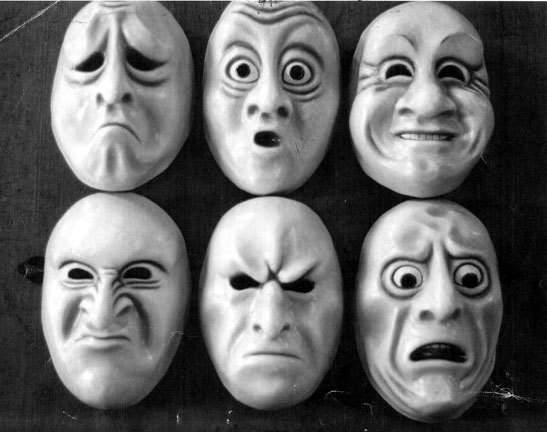How to Reach a Million Video Views – Part 4: Emotions and Meaning

This is part of a series of guest blog posts by the screenwriter and director Gregor Schmidinger will try to reveal the mystery about how to reach a million views with a (narrative) short film on the Internet. Find out more about Gregor at the end of this article.
Previous Posts:
• Part 2: The Art of Filmmaking
Today I want to finish our excursion on story with a scientific look at the two core elements of a compelling stories – emotions and meaning. When we think of movies we usually think of an emotional experience. This seems pretty obvious. Usually we don‘t think so much about meaning but meaning is as equally important, propelling a story into new heights. If we combine both we get something that is even greater than its sum and it‘s called aesthetic emotion. But let‘s start with an evolutionary explanation of emotion and meaning in order do understand why emotional stories with meaning work so well in the first place.
HUMANS ARE EMOTIONAL BEINGS
Do you remember the 80’s movie Short Circuit with that little robot that learns about the difference between being human and being a machine? I loved that movie and watched it every single time it was on TV when I was a child. As you might have guessed, in case you haven‘t seen the movie, the difference is that humans experience emotions such as love, anger and joy. There have been countless movies that express this very idea and they are not that far from reality – maybe a bit cheesy though.
The center of emotions is the limbic system which can be found in higher animals and human beings. It‘s the oldest part of our brain that we share with e.g. reptiles. The limbic system is responsible for our survival and emotions are its language to communicate with our body. It uses emotions to motivate us. A threatening situation makes us feel anxious and we’ll avoid it in the future. When we have sex, it makes us feel good trying to feel that feeling as many times as possible. Emotions simply control and shape our behavior, maintaining our survival. It provided an evolutionary advantage and now we are stuck with it, even when emotions become irrational.
HUMANS ARE ANIMALS SEEKING FOR MEANING
Our understanding tells us that we as human beings differ from other animals. We have consciousness, use symbols to communicate and can reflect about life and ourselves. Evolutionarily speaking, the newest part of our brain, which is way bigger than in other mammals, is the cerebral cortex. It consist of the left and the right hemisphere and is responsible for attention, perceptual awareness and consciousness. This part is what really defines us as human. It‘s also the part of the brain that is responsible for the creation of meaning.
The cerebral cortex creates meaning through narratives. Stories are simply the way of how we make sense of the world. For example, our left hemisphere constantly creates narratives to make the world understandable and predictable. It takes two facts and puts them into relation. Meaning arises through the relation of the two facts.
Hence, human beings are animals seeking for meaning, able to reflect on life and themselves and creating meaning – but nevertheless, everything that we perceive has to go through the limbic system before it is passed along to the cerebral cortex. If you prefer, we can say that we run on two operating systems build on top of each other. Now, if we stimulate both areas at the same time, the limbic system (emotion) as well as the cerebral cortex (meaning) we experience something that is highly enjoyable and often interpreted as a religious experience – it‘s called an aesthetic emotion.
In life, emotion and meaning are usually separated. Let‘s say we see a dead body in the street. We will have an emotional reaction and it won‘t be a pleasant one. It‘s not until later, after we had time to reflect on what we saw, that we can apply meaning to it. Experiencing an emotion and applying meaning to it occur at two different places in time. An aesthetic emotion, on the other hand, is the occurrence of emotion and meaning at the same time.
There is one point in the story of The Boy Next Door that has a strong aesthetic emotion. It is when Justin wants to give Mark 25 dollars to be his friend. It expresses Justin’s desperation that we can connect to thanks to our mirror neurons and experiences we made in our life so far. That‘s the emotional component. At the same time, it expresses a meaning. It makes a statement about the society we live in. A truth if you want. This combination makes it heart wrenching and moves a lot of people to tears.
So when you think about writing a movie always keep in mind what the meaning of your story is both globally of the whole story as well as locally in each scene. Usually we don‘t start with an idea of what the meaning of a story is but as soon as we start writing, it will eventually reveal itself along the way. Then, we can go back and have a look at what we wrote through the lens of the meaning we uncovered.
For more information on what a controlling idea is and how to phrase it in order to use it as the backbone of your story check out my two post Homophobia: A Dialog of Ideas and How to Express a Controlling Idea.
THE MEANING BEHIND THE BOY NEXT DOOR
Globally speaking, the meaning that I tried to express through emotions by the application of experience complexes through characters and their behavior is that we live in a world where we steadily disconnect from each other. Where we use pills to calm ourselves instead of searching the comfort of another human being. Where we are too focused on money and possessions and don‘t appreciate relationships and the value of each and every life as much as we could. Deep down, we crave being connected more closely to others physically as well as emotionally. However, our culture proclaims different values that we try to follow in order to be accepted by our peers. The Boy Next Door does nothing less than expressing these desires, letting the audience experience them for a short moment.
As soon as you’ll start applying all these basic concepts – the concept of the universal truth, the monomyth that is deeply rooted in our dynamic subconscious – and when you express experience complexes through character and their behavior provoking emotions and expressing a meaning through them, then there is a good chance that your story will find an audience, move them, make them think and even transcend time and space into different generations and cultures.
The Boy Next Door is being watched by people from the most different cultures on planet earth. People from Japan and China like it as well as people from Russia, the USA, Kenya, Saudi Arabia or Brazil. The official site of The Boy Next Door had 20.000 visitors from 140 countries in just one year. (There are 194 countries in total).
I discovered the poster of The Boy Next Door on a Chinese bulletin board with a translation of the title and the subtitles. By now, there are multiple versions of The Boy Next on YouTube subtitled in Spanish and the Thai language for example. People wrote fan fiction using the characters of the story. They even uploaded the soundtrack to YouTube.
Another discovery that really struck me was that several porn focused blogs embedded the short. It was weird to find the movie in between of hardcore material. It kind of made me feel uncomfortable at first but I soon realized that this is the best testimony there could be.
Being unable or afraid to properly connect with people emotionally, we can try to compensate it with e.g. sex (like Jack!). Sex is easy accessible even buyable and provides us with an instant positive feedback. Deep emotional relationships on the other hand, that we really want, need time and trust to establish and grow. You can‘t expect a quick development and it most definitely isn‘t buyable. Like Jack, people visit these blogs to find porn but are emotionally touched instead being confronted and comforted with the mirror of innocence showing them that what they really crave isn‘t actually buyable or easy accessible. This is the real life manifestation of the story.
To be honest. All the comments, all the ratings, all the time fans spend to translate and spread the story are so much more worth than any number below a video no matter how high it might be. For me, it simply shows that I succeeded as an artist and a filmmaker and provides me with new motivation to keep going despite the fact that I haven‘t seen just one cent so far.
That‘s why we will leave the area of story and art and have a closer look at the more economic side of The Boy Next Door next week. Looking at target audience, demographic and niche markets before I make a proposition on how to turn all that into actual value. Despite all the artsy and philosophic talking, let‘s face it, this is equally important.
—– Gregor is a screenwriter and director from Austria currently working as a junior creative director and studying screenwriting at UCLA. On his blog BreakingIn he writes about screenwriting, directing and artistic development, documenting his attempt to break into the movie business. You can follow him on Twitter @Breaking_In.
Related Posts
Majorca Masterclass, part 1 – Ending up in a Philip Bloom short film... June 19, 2011 | Nino Leitner

Minute Review – Kessler Parallax January 28, 2014 | Nino Leitner

Auszeit / Time-Out (narrative short film in German)... February 15, 2010 | Nino Leitner

How to pick your next project [guest post]... November 8, 2013 | Pascal Depuhl

How to Reach a Million Video Views -Part 1: The Set Up... February 9, 2011 | Nino Leitner

Beach Cycle: Timelapsing on the French Riviera... August 24, 2010 | Nino Leitner

3 – “Gute Musik” (commercial) – [German] February 15, 2010 | Nino Leitner

3 – “Back to the Future” – [German] February 15, 2010 | Nino Leitner

-
March 7, 2011
If you ignore those aspects and focus only on technicism and/or audience/economic aspects leads you on nothing. This is true on producing every single kind of arts. Content is King, as someone said, no matter how you “transfer” that.
-
March 8, 2011
At last someone who doesn’t repeat all that Syd Fields bullshit, that you learn at lesser film schools.I highly appreciate most of Gregor’s thoughts. Here’s someone who has his own thoughts about movie dramaturgy. Thanks for sharing them.
Submit a Comment
Recent comments
- Canon C300 Mark III - First Look Review & Impressions - Footage | CineD said […] announced, I shot a short film with it and fell in love with that camera – you can w...
- Lucas Triebl, Stefan Fleig & Nino Leitner: Table Connect : Penneylaneonline.com said […] Website: LOA Studio 2. Blog: Nino Leitner 3. […]
- Tom said I found this post while looking up what happened with an update gone wrong on a Sony PXW-X320 and th...
- Canon EOS Rebel T8i Announced – the Entry-Level DSLR Is Still Alive | HDR360pro.com said […] But, some of you probably remember more of the Rebel T2i/550D that came out in 2010 (here’...
- Chris B said Hey, we just shot on the RED Epic Weapon and had issues with “spanned clips”. We ended up stitching...
- Video Production Has Changed, Let's Record With Our Phones?! - Push ROI said […] started in video production during the DSLR revolution. In 2009 a lot of production compan...




















Comments